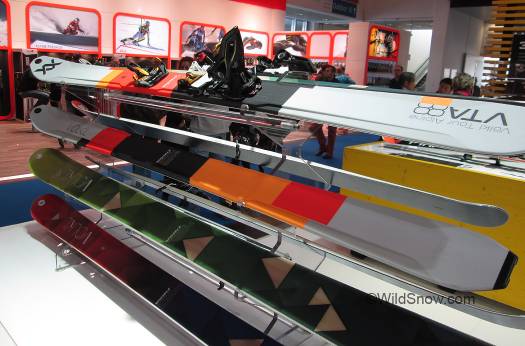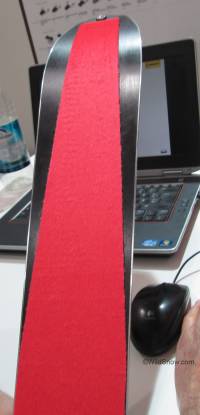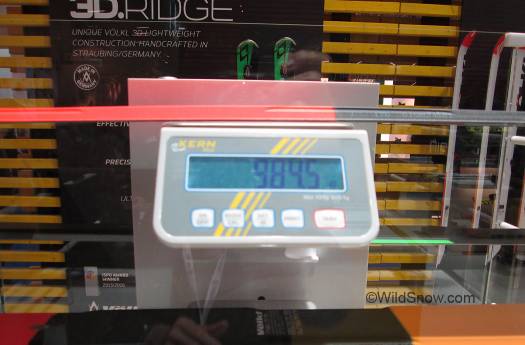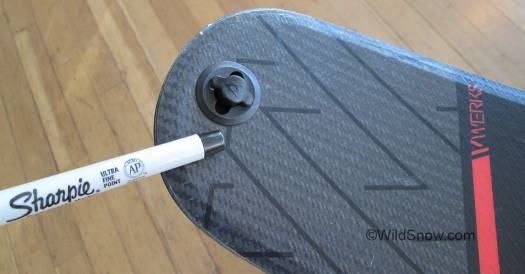
Volkl Tour Alpine VTA ski models have been overshadowed by Kingpin binding problems, but these lightweight versions of the BMT line are worth panting over (after all, am I not occasionally a mouth breathing gear blogger?). For 2015-2016 you’ll see two versions of the VTA, both at 88 mm waist (the sweet spot for core ski touring, in my opinion). Tip is rockered, no tail rocker, 19 meter sidecut with 160,170,180 cm lengths available. The VTA88 Lite is a carbon constructed ski that’ll weigh in at about 1 kilo for a 170 cm length. The non-carbon version of the ski is simply called the VTA88 and weighs 200 grams more. MSRP in Europe will be 800 and 550 euros, respectively. As with the BMT, the mount area will be restricted and in this case marked on the ski so you won’t have any doubt. I’m told most tech bindings will fit the mount area, but ‘three screw’ race bindings will not — though you can still give it a shot only without warranty. A shaped skin will be available that saves noticeable weight over wall-to-wall carpet. (As for the excellent Volkl BMT skis, they remain the same for 2015-2016).
Had a fun meeting with Marker-Volkl at the ISPO in Germany. A couple of their top equipment development guys filled me in. What apparently happened with Kingpin is the well tested pre-production bindings were carefully assembled, especially regarding the press fitting of the steel toe pins in the aluminum “wing” arms of the binding toe. When they industrialized the production, a jig-cradle was used to hold the arms that allowed them to be positioned slightly out of alignment with the pin insertion press, resulting in the steel of the pin damaging the aluminum hole as it was inserted. The damage was obviously not visible enough for visual quality control to spot, and obviously Marker was not testing the bindings for how strong the pin insertion was.

Volkl aggressively cut skins are said to save nearly 20% weight as well as helping with glide. Sadly they still use their keyhole tip fix, our least favorite system.
They’ve now changed the manufacturing process, as well as introducing more testing of the pin insertions, presumably as part of a six sigma quality control system.
So, that’s the engineering side. Regarding how the situation is communicated, they told me their opinion is that having it covered here on WildSnow dot com is simply enough, and that they got their announcement out in a timely fashion indicative of their corporate culture being that of action. I joked that perhaps that also meant the Marker slogan for business management should be “ski every day, use office when necessary.” They laughed and said perhaps in their case that might sometimes be true (don’t tell their boss, and I will use no names.)
As for their policy in terms of replacing the binding toes even when the defect doesn’t occur, I got the impression this is not a big deal, and that problems reported in our comment thread might be the result in a lag between Marker communicating with the retailers about what they’re allowed to return on warranty for credit, or something like that. Recent reports bear this out. Overall, I’m hearing that getting the binding toes replaced is in most cases not a big deal (provided the parts are actually available).
Main thing here at WildSnow.com is that from what I’ve heard from insiders, Marker only sold or otherwise distributed about 2,500 binding pairs that could have this defect. That’s a miniscule number in terms of worldwide retail for ski touring bindings. And out of that number not all are defective. Hence, from their point of view this was not a panic situation. I’d agree with readers here that it is immaterial how many bindings they made; if you have one of the possibly defective units, and that they under-reacted and should have simply offered to replace all bindings from the beginning. But they did what they did, it’s done and done.

Display at the Marker Volkl ISPO booth had a bunch of scales with various skis; check out this sub kilo plank, 984 grams! The Marker-Volkl guys told me that the industry is really taking the WildSnow ‘one kilo ski’ concept seriously, and most makers of ski touring gear want their skis to look good in our surface vs weight chart. A bit disconcerting to garner so much attention — all we wanted to do was figure out how to haul less weight on our feet! We’ll be adding these skis to our weight/surface charts just as soon as we get final metrics for retail versions.
WildSnow.com publisher emeritus and founder Lou (Louis Dawson) has a 50+ years career in climbing, backcountry skiing and ski mountaineering. He was the first person in history to ski down all 54 Colorado 14,000-foot peaks, has authored numerous books about about backcountry skiing, and has skied from the summit of Denali in Alaska, North America’s highest mountain.

